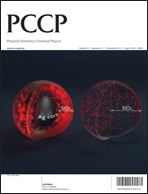Relative contributions of quantum and double layer capacitance to the supercapacitor performance of carbon nanotubes in an ionic liquid
Abstract
Motivated by promising demonstrations of carbon nanotube (CNT) electrodes in supercapacitors, we evaluate the capacitive performance of a (6,6) CNT in [BMIM][PF6] ionic liquid (IL), with particular attention to the relative contributions of the electric double layer (EDL) capacitance (CD) at the CNT/IL interface and the quantum capacitance (CQ) of the CNT. Our classical molecular dynamics simulations reveal that the use of the CNT improves CD when compared to planar graphene, which we discuss in terms of how the electrode curvature affects both the electric field strength and IL packing density. In addition, according to density functional theory calculations, the CQ of the CNT is constant and significantly larger than that of graphene near the Fermi level, which is a consequence of the larger number of available electron states in the CNT. Our study also shows that the relative performance of the CNT- and graphene-based electrodes can be a strong function of applied voltage, which we attribute to the shifting contributions of CQ and CD.


 Please wait while we load your content...
Please wait while we load your content...